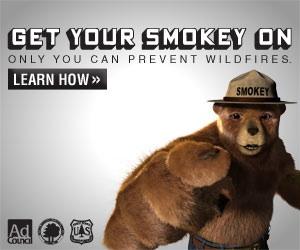Smokey the Bear has been around for decades, but he just got some updating to bring his message about preventing forest fires into the 21st century.
The U.S. Forest Service and National Association of State Foresters recently got together with the folks at the Advertising Council joined to launch a series of public service advertisements and an educational DVD for elementary school students designed to provide critical information to Americans about wildfire prevention.
Since his “birth” on August 9, 1944, Smokey Bear has been a recognized symbol of conservation and protection of America’s forests. His message about wildfire prevention has helped to reduce the number of acres burned annually by wildfires, from about 22 million in 1944 to an average of 6.5 million today, according to a release from the groups.
However, wildfire prevention remains one of the most critical environmental issues affecting the country, they add. Many Americans believe that lightning starts most wildfires. In fact, on average, 9 out of 10 wildfires nationwide are caused by people. The principle causes are campfires left unattended, trash burning on windy days, arson, careless discarding of smoking materials or BBQ coals, and operating equipment without spark arrestors, the groups note.
Created pro bono by ad agency Draftfcb, the same volunteer agency that has created work for the campaign since 1944, the new radio, outdoor and Web public service announcements specifically target young adults who live in the wildland/urban interface— people who are likely to be casual campers, hikers, or mountain bikers — to remind them that Smokey is counting on them to prevent human-caused wildfires.
The PSAs seek to continue to decrease the number of human-caused wildfires and they encourage young adults to “Get Your Smokey On” – that is, to become like Smokey and speak up appropriately when others are acting carelessly.
“’Get Your Smokey On' is a call for each of us to be responsible whenever we use fire,” said Jim Hubbard, the Forest Service's deputy chief for state & private forestry. “Smokey still needs your help in reducing the almost 70,000 wildfires that are human-caused each year.”
Along with the PSAs, the Brigham Young University Ad Lab created a DVD for elementary school teachers and other educational group leaders to communicate Smokey Bear’s important messages. The DVD features a day in the forest with Smokey Bear and tells his story of wildfire prevention. Produced in both English and Spanish and in 3D animation, the DVD also contains curriculum, activities and resources for teachers.
The PSAs direct audiences to visit the campaign’s website, www.smokeybear.com, where they can take a pledge and learn more about wildfire prevention. In addition to the new PSAs and website, Smokey Bear has profile pages on Facebook, MySpace and YouTube to further the reach of his messages to young adults:
* Facebook: www.facebook.com/smokeybear
* Twitter: www.twitter.com/smokey_bear
* MySpace: www.myspace.com/wildfireprevention
* YouTube: www.youtube.com/smokeybear
* Mobile: www.smokeybearmobile.com
This summer, the campaign website and Smokey Bear’s social media channels will feature a new series of interactive games and tools designed to further encourage young adults to “Get Your Smokey On.”
“Smokey Bear’s message is just as critical as it was over 65 years ago when he was first introduced to Americans,” said Peggy Conlon, president and CEO of the Ad Council. “Through social media and by leveraging the latest technologies we have new and effective ways to engage another generation in understanding their role in wildfire prevention.”
Since 1944, Smokey Bear has been communicating his well-known message, “Only You Can Prevent Forest Fires.” In 2001, the term “Wildfires” was introduced to include all unwanted, unplanned fires in natural areas such as grass fires or brush fires.


 Support Essential Coverage of Essential Places
Support Essential Coverage of Essential Places







Comments
You're going to hear from the purists who will tell you it's "Smokey Bear" not "Smokey the Bear."
Sorry, Rangeroo, but it has nothing to do with being a "purist" and everything to do with being correct. Despite the incorrect lyrics of the song, Smokey's name is and always has been "Smokey Bear," no "the."
[Edited for gratuitous remark]
Let's all sing it:
Smokey the Bear
Smokey the Bear
Growlin' & a-prowlin'
& a-sniffin' the air
He can smell a fire
Before it starts to flame
That's why they call him Smokey
That's how he got his name!
I once had a geography professor friend who practically flew into a rage every time he heard somebody say "Sahara desert." He would say, "It's just Sahara, you bloody morons!" We would say "Get a life."
Incidentally, my fussbudget friend was absolutely correct. "Sahara" is the Arabic word for desert, so when someone says Sahara desert, he is saying "desert desert," which is a trifle redundant.
Well - as a completely off the wall aside, the translation of all Spanish into English with "The Los Angeles Angels of Anaheim" would be "The the Angels Angels of Anaheim".
Bob: Did he feel the same about the Sierra Nevada Mountains or the Rio Grande River?
Never did hear Tony complain about those. Just out of curiosity, Rangertoo, how many of those examples do you have? You've cited three very good ones already, and I suspect there may be plenty more where those came from.
OK-this could be the start of a great 'thread'. Here's mine; The La Brea Tar Pits. The literal translation would the 'The the tar tar pits', la brea being Spanish for 'the tar'.